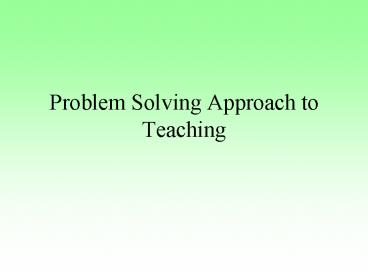Problem Solving Approach to Teaching - PowerPoint PPT Presentation
1 / 15
Title:
Problem Solving Approach to Teaching
Description:
Define the problem/Clarify questions to be answered. Seek data and information ... Students think when they encounter an obstacle ... – PowerPoint PPT presentation
Number of Views:35
Avg rating:3.0/5.0
Title: Problem Solving Approach to Teaching
1
Problem Solving Approach to Teaching
2
Learning Process
Experience a provocative situation
Define the problem/Clarify questions to be
answered
Evaluate the results
Seek data and information
Test proposed solutions
Formulate possible solutions
3
Learning Process vs. Problem Solving Approach
Experience a provocative situation
Interest Approach
Evaluate the results
Define the problem/Clarify questions to be
answered
Evaluate Solution
Group Objectives
Seek data and information
Test proposed solutions
Questions to be Answered
Formulate possible solutions
Test/Apply Solution
Problem Solution
4
Interest Approach
- Principles of Learning
- Students must be motivated to learn
- Readiness is a prerequisite for learning
- Motivation is strongest when students perceive
that learning can be useful
5
Interest Approach
- Techniques to Use
- Raise perplexing questions
- Show specimens or samples
- Present a case study
- Give a skillful demonstration
- Show pictures of success and failure
- Give a project assignment
- Conduct a provocative role play
6
Group Objectives
- Principles of Learning
- Students are motivated through their involvement
in setting goals and planning learning activities - Students progress in acquiring new knowledge and
skills only as far as needed to accomplish their
purposes
7
Group Objectives
- Techniques to Use
- Raise selected lead questions
- Conduct a general discussion
- Result Develop a list of group objectives for
studying the unit
8
Questions to be Answered
- Principles of Learning
- When the subject matter to be learned possesses
meaning, organization, and structure that is
clear to students, learning proceeds more rapidly
and is retained longer. - Students are motivated when they attempt tasks
that fall in a range of challenge such that
success is perceived to be possible but not
certain.
9
Questions to be Answered
- Techniques to Use
- Raise selected lead questions
- Conduct a general discussion
- Result A list of questions the students will
study in order to complete the problem area.
10
Problem Solution
- Principles of Learning Used
- Students think when they encounter an obstacle
- Learning is an active rather than passive process
- Directed learning is more effective than
undirected learning - To maximize learning students should inquire
into rather than be instructed in the subject
matter - Problem oriented approaches improve learning
- Students learn what they practice
- Behaviors that are reinforced are more likely to
be learned - To be most effective, reward must follow as
immediately as possible the desired behavior
11
Problem Solution
- Techniques to Use
- Variety of Teaching Methods
- Assist class in finding, studying, and evaluating
facts, concepts, and skills necessary to answer
the questions, solve the problems, and develop
conclusions
12
Testing the Solution
- Principles of Learning Used
- Supervised practice that is most effective occurs
in a functional educational experience. - Learning is most likely to be used if it is
learned in a real situation and immediately
preceding the time when it is needed
13
Testing the Solution
- Techniques to Use
- Provide practice
- Classroom
- School laboratory
- FFA activities
- Field trips
- SAEs
14
Evaluating the Solution
- Principles of Learning Used
- When students have knowledge of their learning
progress, performance will be superior to what it
would have been without such knowledge.
15
Evaluating the Solution
- Techniques to Use
- Paper and pencil tests
- Checklists
- Competition
- Analysis of financial records































